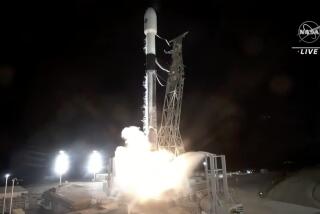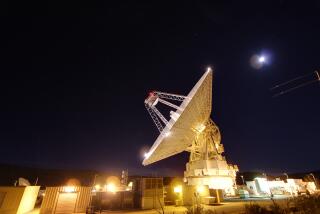With New Man at NASA Controls, Space Agency Is Ready for Overhaul : NASA: The expense and delay of the shuttle has hurt the image of the can-do agency, but a new administrator could well return it to its former glory.
WASHINGTON — Government agencies with deep-seated problems often begin a downward spiral. The state of the agency makes it difficult to attract top managers; poor managers make matters worse; worse problems make it harder to attract leadership talent. In the 1980s, the National Aeronautics and Space Administration was a prime example of this sad phenomenon.
One way to break this cycle is with a gifted administrator who understands a poorly run organization has nowhere to go but up--and whoever makes this happen stands to win great praise. Currently there is guarded optimism that NASA has found such a person in its new administrator, Daniel S. Goldin, confirmed by the Senate in early April, just two weeks after he was nominated.
The important questions about Goldin: how did he get the job; what does he represent, and what should he do?
In February, President Bush dismissed Richard H. Truly, NASA administrator since 1989. A retired Navy admiral and former astronaut, Truly exemplified the old guard, believing the space shuttle was the answer to all space questions.
Truly’s demise came at the hands of Mark Albrecht, chairman of the National Space Council, an advisory panel headed by Vice President Dan Quayle. Albrecht and Truly disliked each other. Albrecht disliked Truly because he felt NASA was freezing out Quayle’s attempts for reform. Truly saw Albrecht as a mosquito buzzing around his ears. But Albrecht worked in the White House, where he could buzz in the President’s ear, too.
Goldin is unusual in that he is a relative outsider, having spent most of his career at TRW. Though TRW is an aerospace contractor, it has long been on the outs with NASA. Here’s why.
Through the moon-race years, TRW was a NASA favorite, designing important components of the Apollo lander. But as Apollo was winding down and new NASA programs were debated, TRW aligned itself with an idea generally known as the “Big Dumb Booster.” In this scheme, NASA would build relatively inexpensive throwaway rockets for launching most space cargo unmanned. NASA, however, decided to risk all on the space shuttle--an expensive system based on the idea that astronauts should be on every space flight, even routine cargo launches. During the early, critical stages of shuttle funding, TRW infuriated NASA by staging tests that suggested Big Dumb Boosters could be more practical. So TRW was frozen out by NASA.
TRW went on to become a leading builder of spy and communication satellites: that is, a customer for NASA launch services. When satellite launch costs rose because the shuttle proved so much more expensive than promised--and when launch services stopped after the Challenger explosion--builders of satellites suffered financially. TRW became bitter.
Though Goldin was not involved in the old Big Dumb Booster project, he spent his professional life in an institutional culture with an anti-NASA flavor. He is the first new NASA administrator not inclined to hold it in awe.
At TRW, Goldin ran some research for the Strategic Defense Initiative. Many SDI believers detest NASA--because there can never be a space defense without putting lots of objects into orbit, and that requires a launch system cheaper and more practical than the shuttle.
Albrecht sensed that he should look within the Strategic Defense Initiative Organization to find credible allies for NASA reform. SDIO, Albrecht discovered, was running a cheap-launcher research bureau whose existence had been hidden--not from the Soviets but from NASA. Last year Albrecht pushed to have Michael Griffin, director of the SDIO cheap-launcher project, made an assistant administrator of NASA. His appointment dropped a depth charge into the agency.
Between Goldin and Griffin, NASA now has two top officials who are outsiders, who don’t have a personal stake in justifying old decisions. So there now exists an opportunity for true reform.
The real challenges of management reform lie in the basics. And NASA’s most pressing basic is this:
NASA will not work again until it rationalizes its space-launch system. Putting objects into space is, after all, the most basic thing NASA does. Yet it now does this intermittently and at astounding cost--by some estimates, almost a $1 billion per shuttle launch. Goldin should:
--Revive the Big Dumb Booster. This could be even better than the one envisioned during the 1960s, with advances such as chip electronics coupled to proven, low-cost components. The throwaway rockets the United States occasionally uses were designed in the 1950s, with engineering assumptions from the Bronze Age of space. NASA used its shuttle monopoly to prevent modern designs from coming into being.
NASA and the Department of Defense have a modern throwaway rocket, called Advanced Launch System, under study. But the space Establishment maneuvered to make ALS a “heavy lifter”--a huge, powerful machine. The National Research Council recently recommended that ALS be oriented around medium-weight space launches.
--Park the shuttle. There are occasional space missions that the shuttle is necessary for--such as life-science research. If the shuttle were launched two or three times a year for such purposes, the astronaut corps would stay in business, the risk of another shuttle failure would be reduced and the billions of dollars saved could be used elsewhere.
--Cancel space station Freedom. Today the Russians are about to abandon their space station, Mir , for lack of things to do there. Why should the United States spend $40 billion for larger, more comfortable version of something the Russians don’t want?
--Shelve the talk of Mars missions and Moon bases. Someday people will walk on Mars and manufacture products on the Moon. And someday Madonna will shop at Laura Ashley. For now, talk of fantastic future missions only distracts NASA from fixing basic launch services.
--Make NASA a science agency. The prime recommendation of Quayle’s Augustine Commission on NASA reform was that science should become the chief concern of space planning. Science is the most cost-effective part of NASA. But the old guard doesn’t like science, because most science missions are carried out by unmanned satellites and probes.
--Find a sensible space flyer for men and women. Many engineers have proposed that NASA build a small “spaceplane” that would be launched from the back of a carrier aircraft, such as a 747.
A system in which improved new throwaway rockets launch the cargo while some simpler, smaller system ferries the people would rationalize U.S. launch services, reduce costs and risks, and bring grand adventures such as Mars travel into the realm of the debatable.
--Work with the Russians. For years NASA, more than its counterpart Soviet agencies, resisted unified space ventures. The official reason was Cold War tensions. The real reason has been that NASA is driven crazy by the fact that the former Soviet Union launches nearly 10 times as many annual space missions--because the Russians stage their launches with affordable “dumb” hardware.
Joint U.S.-C.I.S. space operations would not merely save both nations money. Travel to Mars is impossible to justify on scientific grounds. But a joint Mars project might give former enemies a lasting peaceful mutual objective.
Another Augustine Commission recommendation, also greeted with a sneer by the NASA Establishment, was that the agency regularly seek outside advice. NASA Establishment types insist only experts can understand the technical aspects of the space business.
True, but irrelevant. John F. Kennedy was no rocket scientist. Yet his ideals and instincts for NASA direction proved invaluable to the agency.
Now, to the surprise of many (including me), Quayle has shown similar instincts, shaking up NASA more profoundly than anyone since Kennedy. Let’s hope he picked the right man in Goldin. NASA has nowhere to go but up.
More to Read
Sign up for Essential California
The most important California stories and recommendations in your inbox every morning.
You may occasionally receive promotional content from the Los Angeles Times.










